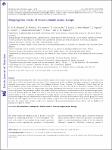Mapping low intake of micronutrients across Europe
Mensink, Gert
Fletcher, Reg
Gurinovic, M.
Huybrechts, I.
Lafay, L.
Serra-Majem, Lluis
Szponar, Lucjan
Tetens, Inge
Verkaik-Kloosterman, J.
Baka, A.
Stephen, A. M.
Achieving an understanding of the extent of micronutrient adequacy across Europe is a major challenge. The main objective of the present study was to collect and evaluate the prevalence of low micronutrient intakes of different European countries by comparing recent nationally representative dietary survey data from Belgium, Denmark, France, Germany, The Netherlands, Poland, Spain and the United Kingdom. Dietary intake information was evaluated for intakes of Ca, Cu, I, Fe, Mg, K, Se, Zn and the vitamins A, B1, B2, B6, B12, C, D, E and folate. The mean and 5th percentile of the intake distributions were estimated for these countries, for a number of defined sex and age groups. The percentages of those with intakes below the lower reference nutrient intake and the estimated average requirement were calculated. Reference intakes were derived from the UK and Nordic Nutrition Recommendations. The impact of dietary supplement intake as well as inclusion of apparently low energy reporters on the estimates was evaluated. Except for vitamin D, the present study suggests that the current intakes of vitamins from foods lead to low risk of low intakes in all age and sex groups. For current minerals, the study suggests that the risk of low intakes is likely to appear more often in specific age groups. In spite of the limitations of the data, the present study provides valuable new information about micronutrient intakes across Europe and the likelihood of inadequacy country by country.
Dateien zu dieser Publikation
Keine Lizenzangabe

